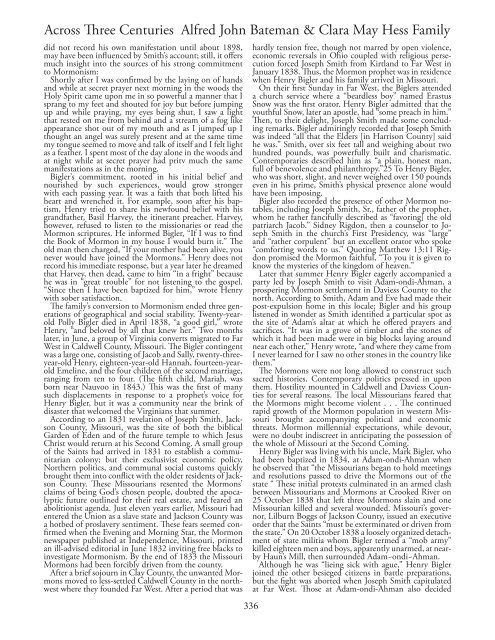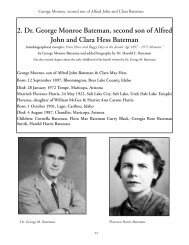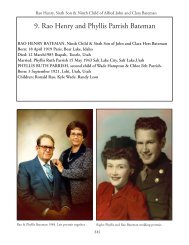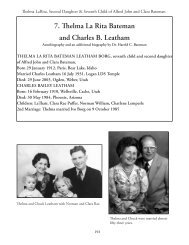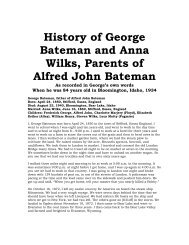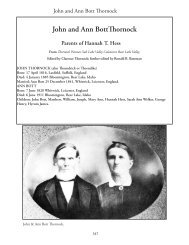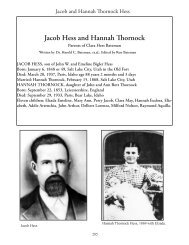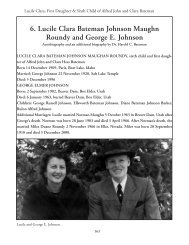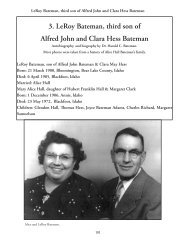John W. Hess and Emeline Bigler Grandparents of ... - Bateman Family
John W. Hess and Emeline Bigler Grandparents of ... - Bateman Family
John W. Hess and Emeline Bigler Grandparents of ... - Bateman Family
Create successful ePaper yourself
Turn your PDF publications into a flip-book with our unique Google optimized e-Paper software.
Across Three Centuries Alfred <strong>John</strong> <strong>Bateman</strong> & Clara May <strong>Hess</strong> <strong>Family</strong>did not record his own manifestation until about 1898,may have been influenced by Smith’s account; still, it <strong>of</strong>fersmuch insight into the sources <strong>of</strong> his strong commitmentto Mormonism:Shortly after I was confirmed by the laying on <strong>of</strong> h<strong>and</strong>s<strong>and</strong> while at secret prayer next morning in the woods theHoly Spirit came upon me in so powerful a manner that Isprang to my feet <strong>and</strong> shouted for joy but before jumpingup <strong>and</strong> while praying, my eyes being shut, I saw a lightthat rested on me from behind <strong>and</strong> a stream <strong>of</strong> a fog likeappearance shot out <strong>of</strong> my mouth <strong>and</strong> as I jumped up Ithought an angel was surely present <strong>and</strong> at the same timemy tongue seemed to move <strong>and</strong> talk <strong>of</strong> itself <strong>and</strong> I felt lightas a feather. I spent most <strong>of</strong> the day alone in the woods <strong>and</strong>at night while at secret prayer had pritv much the samemanifestations as in the morning.<strong>Bigler</strong>’s commitment, rooted in his initial belief <strong>and</strong>nourished by such experiences, would grow strongerwith each passing year. It was a faith that both lifted hisheart <strong>and</strong> wrenched it. For example, soon after his baptism,Henry tried to share his newfound belief with hisgr<strong>and</strong>father, Basil Harvey, the itinerant preacher. Harvey,however, refused to listen to the missionaries or read theMormon scriptures. He informed <strong>Bigler</strong>, “If I was to findthe Book <strong>of</strong> Mormon in my house I would burn it.” Theold man then charged, “If your mother had been alive, younever would have joined the Mormons.” Henry does notrecord his immediate response, but a year later he dreamedthat Harvey, then dead, came to him “in a fright” becausehe was in “great trouble” for not listening to the gospel.“Since then I have been baptized for him,” wrote Henrywith sober satisfaction.The family’s conversion to Mormonism ended three generations<strong>of</strong> geographical <strong>and</strong> social stability. Twenty-yearoldPolly <strong>Bigler</strong> died in April 1838, “a good girl,” wroteHenry, “<strong>and</strong> beloved by all that knew her.” Two monthslater, in June, a group <strong>of</strong> Virginia converts migrated to FarWest in Caldwell County, Missouri. The <strong>Bigler</strong> contingentwas a large one, consisting <strong>of</strong> Jacob <strong>and</strong> Sally, twenty-threeyear-oldHenry, eighteen-year-old Hannah, fourteen-yearold<strong>Emeline</strong>, <strong>and</strong> the four children <strong>of</strong> the second marriage,ranging from ten to four. (The fifth child, Mariah, wasborn near Nauvoo in 1843.) This was the first <strong>of</strong> manysuch displacements in response to a prophet’s voice forHenry <strong>Bigler</strong>, but it was a community near the brink <strong>of</strong>disaster that welcomed the Virginians that summer.According to an 1831 revelation <strong>of</strong> Joseph Smith, JacksonCounty, Missouri, was the site <strong>of</strong> both the biblicalGarden <strong>of</strong> Eden <strong>and</strong> <strong>of</strong> the future temple to which JesusChrist would return at his Second Coming. A small group<strong>of</strong> the Saints had arrived in 1831 to establish a communitariancolony; but their exclusivist economic policy,Northern politics, <strong>and</strong> communal social customs quicklybrought them into conflict with the older residents <strong>of</strong> JacksonCounty. These Missourians resented the Mormons’claims <strong>of</strong> being God’s chosen people, doubted the apocalypticfuture outlined for their real estate, <strong>and</strong> feared anabolitionist agenda. Just eleven years earlier, Missouri hadentered the Union as a slave state <strong>and</strong> Jackson County wasa hotbed <strong>of</strong> proslavery sentiment. These fears seemed confirmedwhen the Evening <strong>and</strong> Morning Star, the Mormonnewspaper published at Independence, Missouri, printedan ill-advised editorial in June 1832 inviting free blacks toinvestigate Mormonism. By the end <strong>of</strong> 1833 the MissouriMormons had been forcibly driven from the county.After a brief sojourn in Clay County, the unwanted Mormonsmoved to less-settled Caldwell County in the northwestwhere they founded Far West. After a period that washardly tension free, though not marred by open violence,economic reversals in Ohio coupled with religious persecutionforced Joseph Smith from Kirtl<strong>and</strong> to Far West inJanuary 1838. Thus, the Mormon prophet was in residencewhen Henry <strong>Bigler</strong> <strong>and</strong> his family arrived in Missouri.On their first Sunday in Far West, the <strong>Bigler</strong>s attendeda church service where a “beardless boy” named ErastusSnow was the first orator. Henry <strong>Bigler</strong> admitted that theyouthful Snow, later an apostle, had “some preach in him.”Then, to their delight, Joseph Smith made some concludingremarks. <strong>Bigler</strong> admiringly recorded that Joseph Smithwas indeed “all that the Elders [in Harrison County] saidhe was.” Smith, over six feet tall <strong>and</strong> weighing about twohundred pounds, was powerfully built <strong>and</strong> charismatic.Contemporaries described him as “a plain, honest man,full <strong>of</strong> benevolence <strong>and</strong> philanthropy.”25 To Henry <strong>Bigler</strong>,who was short, slight, <strong>and</strong> never weighed over 150 poundseven in his prime, Smith’s physical presence alone wouldhave been imposing.<strong>Bigler</strong> also recorded the presence <strong>of</strong> other Mormon notables,including Joseph Smith, Sr., father <strong>of</strong> the prophet,whom he rather fancifully described as “favoring] the oldpatriarch Jacob.” Sidney Rigdon, then a counselor to JosephSmith in the church’s First Presidency, was “large”<strong>and</strong> “rather corpulent” but an excellent orator who spoke“comforting words to us.” Quoting Matthew 13:11 Rigdonpromised the Mormon faithful, “To you it is given toknow the mysteries <strong>of</strong> the kingdom <strong>of</strong> heaven.”Later that summer Henry <strong>Bigler</strong> eagerly accompanied aparty led by Joseph Smith to visit Adam-ondi-Ahman, aprospering Mormon settlement in Daviess County to thenorth. According to Smith, Adam <strong>and</strong> Eve had made theirpost-expulsion home in this locale; <strong>Bigler</strong> <strong>and</strong> his grouplistened in wonder as Smith identified a particular spot asthe site <strong>of</strong> Adam’s altar at which he <strong>of</strong>fered prayers <strong>and</strong>sacrifices. “It was in a grove <strong>of</strong> timber <strong>and</strong> the stones <strong>of</strong>which it had been made were in big blocks laying aroundnear each other,” Henry wrote, “<strong>and</strong> where they came fromI never learned for I saw no other stones in the country likethem.”The Mormons were not long allowed to construct suchsacred histories. Contemporary politics pressed in uponthem. Hostility mounted in Caldwell <strong>and</strong> Daviess Countiesfor several reasons. The local Missourians feared thatthe Mormons might become violent . . . The continuedrapid growth <strong>of</strong> the Mormon population in western Missouribrought accompanying political <strong>and</strong> economicthreats. Mormon millennial expectations, while devout,were no doubt indiscreet in anticipating the possession <strong>of</strong>the whole <strong>of</strong> Missouri at the Second Coming.Henry <strong>Bigler</strong> was living with his uncle, Mark <strong>Bigler</strong>, whohad been baptized in 1834, at Adam-ondi-Ahman whenhe observed that “the Missourians began to hold meetings<strong>and</strong> resolutions passed to drive the Mormons out <strong>of</strong> thestate “ These initial protests culminated in an armed clashbetween Missourians <strong>and</strong> Mormons at Crooked River on25 October 1838 that left three Mormons slain <strong>and</strong> oneMissourian killed <strong>and</strong> several wounded. Missouri’s governor,Lilburn Boggs <strong>of</strong> Jackson County, issued an executiveorder that the Saints “must be exterminated or driven fromthe state.” On 20 October 1838 a loosely organized detachment<strong>of</strong> state militia whom <strong>Bigler</strong> termed a “mob army”killed eighteen men <strong>and</strong> boys, apparently unarmed, at nearbyHaun’s Mill, then surrounded Adam~ondi~Ahman.Although he was “lieing sick with ague,” Henry <strong>Bigler</strong>joined the other besieged citizens in battle preparations,but the fight was aborted when Joseph Smith capitulatedat Far West. Those at Adam-ondi-Ahman also decided336


